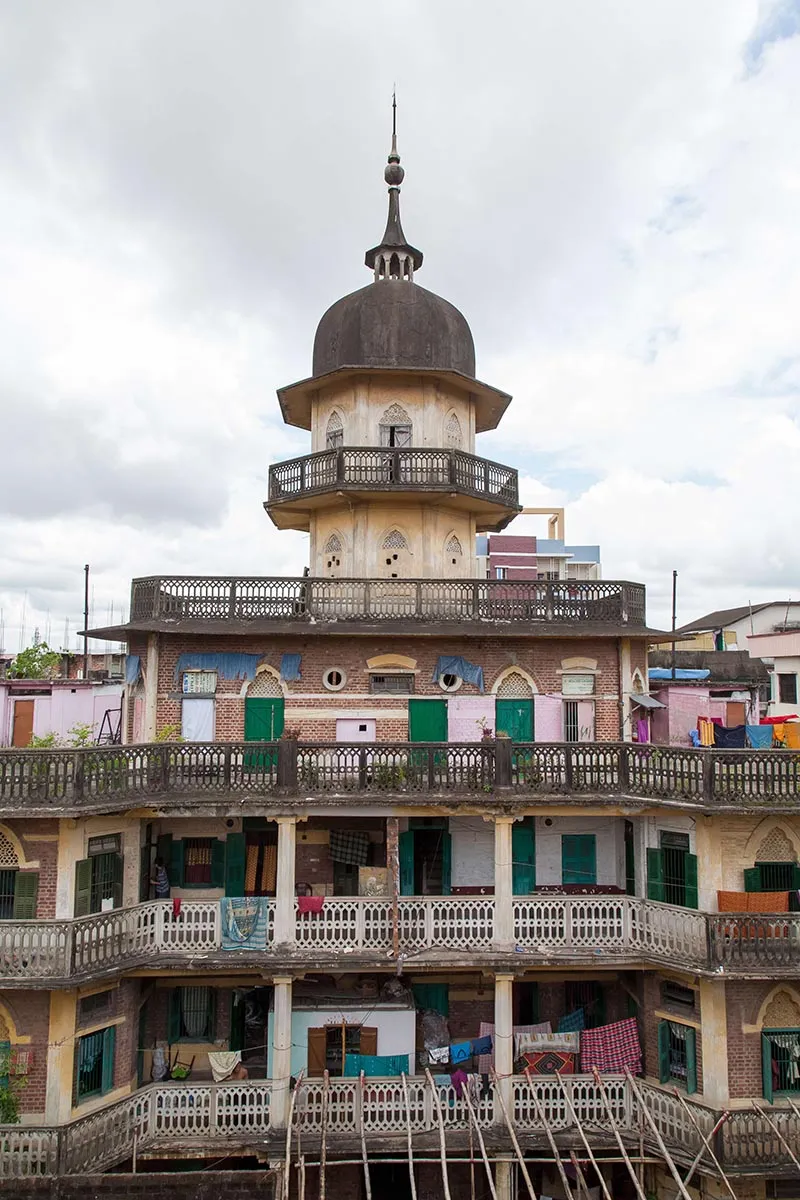Chittagong, a city steeped in history, is a treasure trove of cultural and architectural heritage. Among its most iconic landmarks is the PK Sen Bhaban, also known as the “Sat-tala Bhaban” or “Seven-Story Building,” located in the bustling Sadarghat area. My visit to this remarkable structure in 2016, facilitated by the URONTO residency program, opened my eyes to the historical richness of my hometown. While the beauty of the building captivated me, its neglected state was a poignant reminder of the need to preserve our heritage.
A Glimpse into the PK Sen Bhaban
Constructed in the 1920s by Zamindar Prasanna Kumar Sen, the PK Sen Bhaban stands as a testament to Chittagong’s architectural legacy. The building’s unique design combines elements of subcontinental Hindu temples, Islamic motifs, and European Gothic influences. Though only four stories high, the dome and towering minarets add the illusion of seven stories, making it one of the tallest structures in Chittagong during the British era.
The building features wide windows, geometric ventilators, and hexagonal shapes that are rare in traditional South Asian architecture. It houses over 40 rooms and includes two grand staircases, further adding to its charm. PK Sen, a rice and oil trader with a generous spirit, envisioned this architectural masterpiece to reflect his stature and success.
The URONTO Residency Experience
In 2016, the URONTO team selected the PK Sen Bhaban for its fifth season of artistic exploration. This initiative brought together national and international artists who reimagined the essence of the building through various creative expressions. Participating artists included talents from India, Brazil, Hong Kong, and Bangladesh, along with students from the Chittagong Fine Art Institute.
What made this residency particularly unique was that the building was not abandoned. It still housed tenants, including members of the Ghosh family, the building’s current owners. This dynamic environment provided an extraordinary opportunity for artists to engage directly with the living history of the space.

The Legacy of PK Sen Bhaban
Beyond its architectural brilliance, the PK Sen Bhaban is a silent witness to the evolving history of Chittagong. During the Partition of 1947, PK Sen sold the building to Sadananda Ghosh, and subsequent years saw the structure endure significant trials, including damage during the Liberation War of 1971. The war left the building scarred, with broken windows, looted possessions, and a tragic loss for the Ghosh family.
Despite these adversities, the building continues to stand—a symbol of resilience. Its rich history, however, is overshadowed by decades of neglect. Crumbling plaster, broken staircases, and a lack of maintenance threaten its survival.

Challenges in Preservation
Efforts to preserve the PK Sen Bhaban have been sporadic and largely ineffective. While the Chattogram Development Authority recognizes the building’s cultural significance, bureaucratic hurdles and financial constraints have stalled any concrete steps toward restoration. The current owners, frustrated by the lack of support, even considered demolishing the structure to make way for new developments.
Urban planner Zarina Hossain and architect Huda Mohammed Faisal have highlighted the architectural rarity of the PK Sen Bhaban. Their advocacy underscores the need for immediate action to prevent the loss of this irreplaceable heritage site.


A Call for Action
The neglect of PK Sen Bhaban mirrors a broader issue: the undervaluation of heritage buildings in Bangladesh. These structures are not merely relics of the past; they are living connections to our history and identity. As I walked through the crisscrossing stairs and gazed at the intricate designs, I felt both pride and sorrow. Pride in the legacy of my city, and sorrow at the risk of losing it forever.
The government, local authorities, and heritage organizations must collaborate to restore and preserve the PK Sen Bhaban. Public awareness campaigns, grants for restoration, and inclusion in heritage tourism could breathe new life into this architectural gem. Initiatives like the URONTO residency play a vital role in reintroducing these spaces to the public, reminding us of their cultural and artistic value.
Conclusion
My visit to PK Sen Bhaban was a transformative experience. It deepened my appreciation for Chittagong’s heritage and reinforced the urgency of preserving it for future generations. The grandeur of the PK Sen Bhaban may have faded with time, but its spirit endures. It is a symbol of our city’s resilience and creativity—a legacy worth protecting.
Through collective effort and a renewed sense of responsibility, we can ensure that structures like PK Sen Bhaban remain standing, not as ruins of the past, but as proud monuments to our shared history.


Leave a Reply